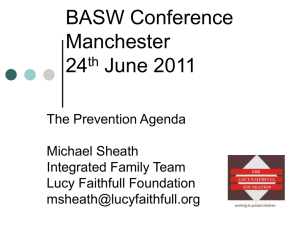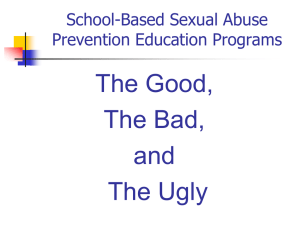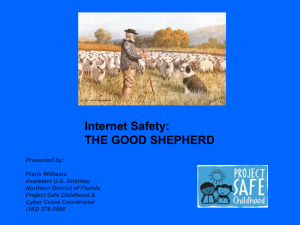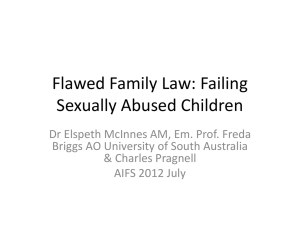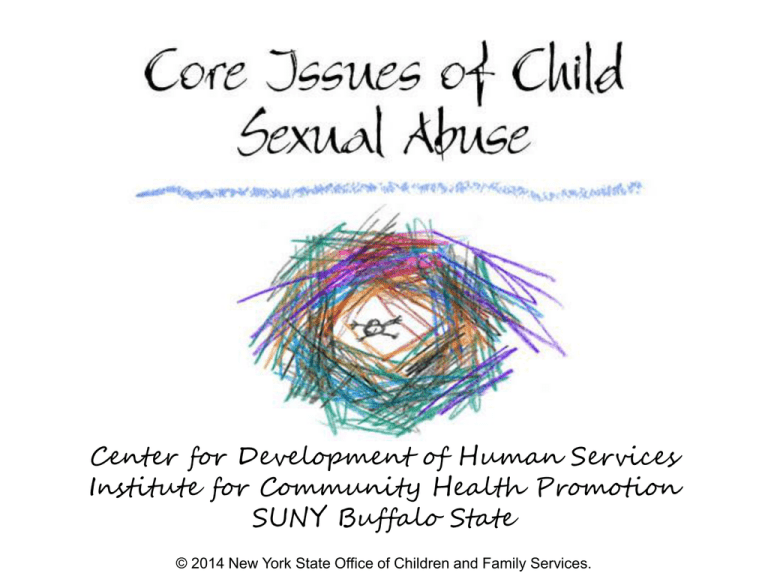
Center for Development of Human Services
Institute for Community Health Promotion
SUNY Buffalo State
© 2014 New York State Office of Children and Family Services.
Core Issues
1. Understanding and discussing
child sexual abuse
2. Identifying signs and effects of
child sexual abuse
3. Understanding and managing
behaviors to meet child’s needs
© 2014 New York State Office of Children and Family Services.
Trainer’s Expectations
• Maintain confidentiality
• Demonstrate respect
• Actively participate – use
text chat or raise hand
• Take some risks
• Use the right to pass
© 2014 New York State Office of Children and Family Services.
Trainer’s Offers
• Keep this a safe place to share
and practice
• Begin/end on time
• Provide information and coach
• Maintain confidentiality
• Enjoy!
© 2014 New York State Office of Children and Family Services.
Session 1: Understanding and
Discussing Child Sexual
Abuse (CSA)
Foster parents need to build relationships that
free children from adult roles. This session
explores family member’s emotions, needs
and behaviors in families where CSA occurs. It
also provides a safe forum to vent feelings
about CSA so new information can be
integrated.
© 2014 New York State Office of Children and Family Services.
TRAUMA
© 2014 New York State Office of Children and Family Services.
Trauma is contagious.
• When we listen to stories of pain, suffering
and fear, we can experience pain,
suffering and fear
….because we care.
© 2014 New York State Office of Children and Family Services.
Child Sexual Abuse:
Definitions
• Sexual touching or fondling
• Exposing children to adult sexual activity or
pornographic materials
• Having children pose, undress, or perform in
a sexual fashion
• “Peeping” into bathroom or bedroom to spy
on child
• Raping/attempting rape
© 2014 New York State Office of Children and Family Services.
The Sculpture:
When CSA occurs in families…
© 2014 New York State Office of Children and Family Services.
Roadwork for Session 3
Complete worksheet on Handout 11: The
Double Trauma
of Sexual Abuse and Placement.
Be prepared to identify the child’s
needs and strategies to meet the needs
for each issue.
© 2014 New York State Office of Children and Family Services.
Session 2: Identifying Signs and
Effects of Child Sexual Abuse
This class also examines family
relationships where CSA has occurred
and the role reversals which children
and adults often experience. Foster
parents need to see children’s behavior
as an expression of underlying needs
and they need to identify the range of
behaviors related to CSA.
© 2014 New York State Office of Children and Family Services.
Myths About Child
Sexual Abuse
• Girls are regularly sexually
abused while boys are rarely
sexually abused
• The person who abuses is “sick”
and beyond help
• A parent who doesn’t abuse
and misses the hints is
equally at fault
© 2014 New York State Office of Children and Family Services.
- Case Models 1. Read assigned case model
2. Review Handout 5 Case Studies: Signs
of Sexual Abuse, and Handout 6, Sexual
and Nonsexual Behavioral Signs of
Abuse
3. Answer questions on worksheet
© 2014 New York State Office of Children and Family Services.
Definition of Needs
Conditions that require relief within an
individual or a family and which, when
relieved or met, enable the person or
group to be responsible to each other
© 2014 New York State Office of Children and Family Services.
Five Human Needs
1. Survival (physiological)
2. Safety
3. Love and belonging
4. Self-esteem
5. Making some dreams
come true
(self-actualization)
© 2014 New York State Office of Children and Family Services.
Maslow’s Hierachy of Human
Needs
Self
Actualiztion
Self-Esteem
Love and Belonging
Safety
Survival
© 2014 New York State Office of Children and Family Services.
Safety Needs
• Shelter
• Structure
• Security
• Order
• Stability
• Law
• Dependency
• Limits
• Freedom from fear,
anxiety, chaos
• Protection
© 2014 New York State Office of Children and Family Services.
Love and Belonging Needs
• Giving love
• Affiliation
• Receiving love
• Being liked
• Affection
• Being accepted
© 2014 New York State Office of Children and Family Services.
Self-Esteem Needs
• Strength
• Respect from others
• Achievement
• Status
• Adequacy
• Recognition
• Mastery
• Attention
• Competence
• Importance
• Confidence
• Dignity
• Independence
• Appreciation
• Freedom
© 2014 New York State Office of Children and Family Services.
Components of
Self-Concept
• Lovable
• Worthwhile
• Capable
• Responsible
© 2014 New York State Office of Children and Family Services.
Making Dreams Come True…
© 2014 New York State Office of Children and Family Services.
Cycle of Need
Need
(Survival or
Safety)
Expression
(Crying)
Need is Met
Relaxation
(Parental
Response)
© 2014 New York State Office of Children and Family Services.
Cycle of Unmet Need
Need
(Survival/Safety)
Scared
Restless
Angry
Expression
(Crying)
Response
Doesn’t Meet
Need
© 2014 New York State Office of Children and Family Services.
Cycle of Need in Child
Sexual Abuse
Need
(Affection)
Expression
(Eager to
please
Asks for
hugs)
Afraid
Confused
Angry
Need is Met
by Sexual
Abuse
© 2014 New York State Office of Children and Family Services.
Effects of Sexual Abuse
• Guilt
• Fear
• Being shocked by sex
(traumatic sexualization)
– Separation and
abandonment
• Acting older
(pseudomaturity)
– Physical damage or
injury
• Not being able to grow
up and develop as most
children do (failure to
complete developmental
tasks)
– Retaliation
– Betrayal
• Low self-esteem
• Having poor social skills
© 2014 New York State Office of Children and Family Services.
Practice Activity
1.
Use Handout 9: Case Study: Cathy Jones
2.
Identify Cathy’s
•
•
•
•
Emotions
Behaviors
Underlying needs
Strengths
© 2014 New York State Office of Children and Family Services.
14 Guidelines
1.
Offer support in clear way
2.
Develop and stick to daily
routine
3.
Provide child privacy
4.
Help child label feelings
5.
Help child express feelings
6.
Help child state needs
clearly
7.
Catch child behaving well
8.
Encourage creative
expression
9. Help child have fun
10. Provide child with information
11. Provide child with physical
outlets
12. Encourage creative
expression
13. Be aware of increased risk to
child of more abuse/take
steps to prevent it
14. Don’t take another placement
if you’re having trouble
managing those in your care
© 2014 New York State Office of Children and Family Services.
Three Phases of Adjustment
to Placement
1. Early
2. Acute
3. Integration
© 2014 New York State Office of Children and Family Services.
Session 3: Understanding and
Managing the Child’s Behavior
Children who’ve suffered CSA
experience a double trauma: that of the
abuse and, secondly, that of placement.
This class helps foster parents plan
ways to meet needs, while managing
challenging behaviors related to the
traumas of CSA and adjustment to
foster care.
© 2014 New York State Office of Children and Family Services.
Practice Directions:
Portia and Jason
1. Read Handout 13 and assigned case
2. Practice applying concepts:
• Meeting underlying needs
• Stages of adjustment placement
• 11 issues of dual trauma
© 2014 New York State Office of Children and Family Services.
Most Frequent and
Bothersome Behaviors
• Seductive behavior
• Angry, aggressive behavior
• Alcohol and substance use
• Suicide attempts
• Running away
© 2014 New York State Office of Children and Family Services.
Laura, Stephen, and Susan
1. Use Handout 16, Handling Challenging
Behaviors and Handout 17, Expressing
Needs and Ways to Meet Needs
2. Answer questions
© 2014 New York State Office of Children and Family Services.
Involving a Child in
Managing Behaviors
1. Begin with positives
2. Validate the underlying needs
3. Use simple words to describe the
inappropriate behaviors
4. Describe behaviors for meeting needs
in simple terms
© 2014 New York State Office of Children and Family Services.
More Practice:
Laura, Stephen, and Susan
1.
2.
Read Handout 18 and review assigned case
Assign a role to each in group:
•
•
•
3.
4.
5.
Foster Parent
Child
Observer
Act out roles for 2 minutes and give feedback
Switch roles
Repeat process until each has experienced
every role
© 2014 New York State Office of Children and Family Services.
Practice Applying Concepts
• Meeting underlying
needs
• Recognizing stages of
adjustment to
placement
• Identifying the 11
issues of dual trauma
© 2014 New York State Office of Children and Family Services.
That’s all folks. Thank you!
You’ll receive an email link to the course’s
post-test. Once this is completed and
submitted, your certificate will be generated
and emailed to you.
We hope to see you in another iLinc class
soon!
© 2014 New York State Office of Children and Family Services.
Unregistered and want training credit?
Before class ends, enter the following into (private) text chat to
Matthew Fildes (in his absence, to the instructor):
Full legal name
Male or female
Home address (no P.O. boxes)
Area code and phone number
Email address (2 on same computer must list 2 email
addresses)
Foster care agency address (e.g., Harlem Dowling,
Westside Center, 2090 7th Ave, NY, NY 10027)
Thank you.
© 2014 New York State Office of Children and Family Services.




